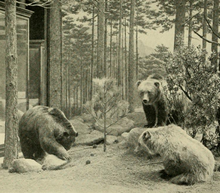- Mexican grizzly bear
-
Mexican grizzly bear 
Conservation status Scientific classification Kingdom: Animalia Phylum: Chordata Class: Mammalia Order: Carnivora Family: Ursidae Genus: Ursus Species: U. arctos Trinomial name Ursus arctos nelsoni
Merriam, 1914Synonyms - Ursus horribilis nelsoni
- Ursus nelsoni
The Mexican grizzly bear (Ursus arctos nelsoni) is a presumed extinct subspecies of the Brown bear. It is named after American naturalist Edward William Nelson who secured a series for the U. S. Biological Survey. The holotype was shot by H. A. Cluff at Colonia Garcia, Chihuahua in 1899.[1]
Contents
Description
The Mexican grizzly bear was one of the heaviest and largest mammals in Mexico. It reached a length up to 183 centimetres and an average weight of 318 kilograms. Due to its silver fur it was often named "el oso plateado" (the silver bear)[2] The Mexican grizzly bear was smaller than the grizzly bears in the United States and Canada. The general color was pale buffy yellowish varying to grayish-white, grizzled from the darker color of the underfur. Specimens in worn pelage varied to yellowish-brown and occasionally to rusty. The longest fur hairs were on the throat and the flanks. The belly was sparsely haired lacking the thick underfur of the back and the flanks.[1]
Range and Habitat
The Mexican grizzly bear inhabited the northern territories of Mexico in particular the temperate grasslands and mountainous pine forests. Its previous range reached from Arizona to New Mexico and Mexico.
Biology
Its diet consisted mainly on plants, fruits and insects. Occasionally it fed also from small mammals and carrion. One to three cubs were born all three years.
Extinction
The first Europeans to come in contact with the Mexican grizzly bear were the conquistadors in the 16th century when Francisco Vásquez de Coronado went on an expedition to find the Seven Cities of Gold. His trudge began in Mexico City in 1540 and went north to New Mexico and the Buffalo Plains in the modern-day U.S. states of Texas and Kansas. Because the bears preyed on livestock from time to time they were considered a pest by the farmers. The Mexican grizzly bear was trapped, shot and poisoned, and had already become scarce in the 1930s. Its former range decreased to the three isolated mountains Cerro Campano, Santa Clara, and Sierra del Nido 80 km north of Chihuahua in the state of Chihuahua. By 1960 only 30 of them were left. Despite its protected status the hunting continued. By 1964 the Mexican grizzly bear was regarded as extinct. After rumours of some surviving individuals on a ranch at the headwaters of the Yaqui River in the state of Sonora in 1969, American biologist Dr. Carl B. Koford went on a three-month survey but without success.
References
Notes
- ^ a b Clinton Hart Merriam: Descriptions of New Bears of North America In: Proceedings of the Biological Society of Washington (1914), p.190-191.
- ^ David Day: The Doomsday Book of Animals. Ebury Press, London
Further reading
- Walton Beacham: World Wildlife Fund Guide to Extinct Species of Modern Times, 1997, ISBN 0933833407
- Julian Huxley, Martyn Bramwell et al.: The Atlas of World Wildlife, 1973
- David Day: The Doomsday Book of Animals. Ebury Press, London 1981, ISBN 0670279870.
External links
Categories:- IUCN Red List extinct species
- Carnivora stubs
- Fauna of Mexico
- Mammal extinctions since 1500
- Extinct carnivorans
- Bears
Wikimedia Foundation. 2010.

